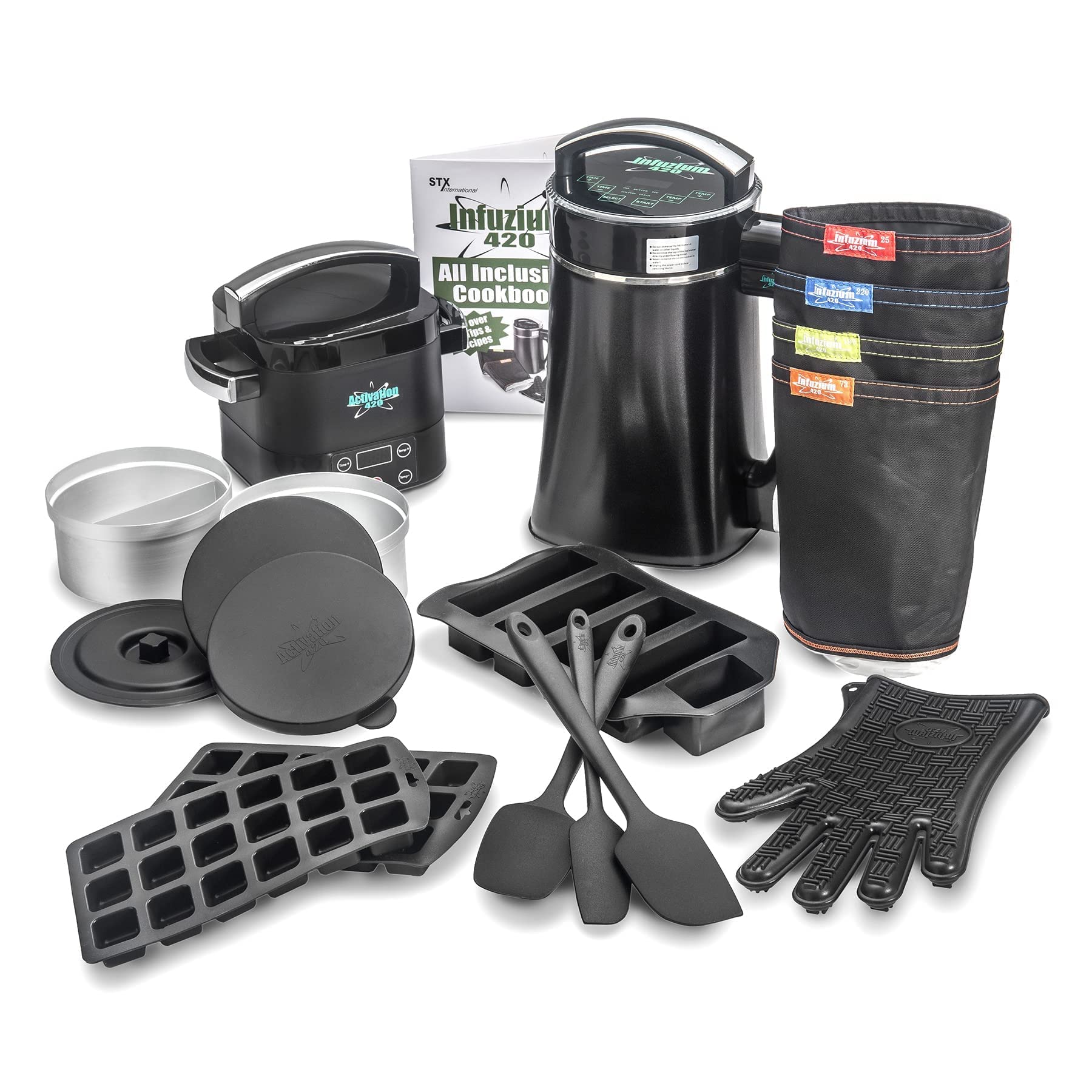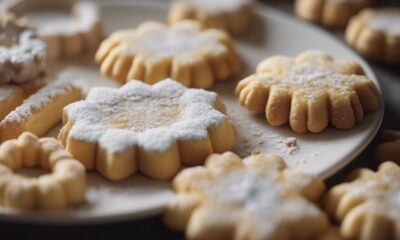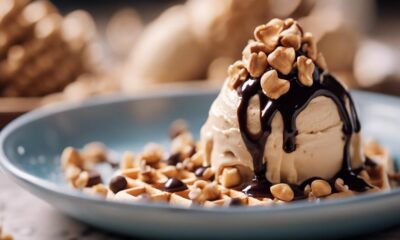Recipes & Culinary Uses
What Happens if Your Dog Eats a Stick of Butter: A Comprehensive Guide

You may have heard the saying, “Curiosity killed the cat,” but have you ever considered what happens when a dog gets ahold of a stick of butter? Trust me, it can lead to quite a mess.
Digestive issues, the risk of pancreatitis, and the potential for choking are just a few of the concerns. Not to mention the increased fat intake and possible toxicity.
So, let’s dive in and explore what happens when our furry friends indulge in this creamy temptation.
Key Takeaways
- Consuming a large amount of butter can overwhelm a dog’s digestive system, leading to bloating, stomach pain, and diarrhea.
- The high fat content in butter can contribute to weight gain in dogs.
- Dogs who consume a stick of butter are at an increased risk of pancreatitis, which can cause symptoms such as abdominal pain, nausea, vomiting, fever, and loss of appetite.
- Butter poses a choking hazard for dogs, and it is important to cut food into small, bite-sized pieces and encourage slow eating to prevent choking incidents.
Potential Digestive Issues
If I eat a stick of butter, it can potentially cause digestive issues. Consuming a large amount of butter can overwhelm the digestive system, leading to discomfort and potential allergies.
Butter is high in fat and can be difficult for the body to break down, especially in large quantities. This can result in bloating, stomach pain, and diarrhea.
Additionally, butter is calorie-dense and can contribute to weight gain if consumed in excess. The body stores excess calories from fat, leading to an increase in body weight over time.
It’s important to consume butter in moderation and be aware of its potential impact on digestion and weight. If you experience any digestive issues or suspect allergies, it’s recommended to consult a healthcare professional.
Risk of Pancreatitis
I should be aware of the risk of pancreatitis if I eat a stick of butter. Pancreatitis is a condition where the pancreas becomes inflamed, and it can have potential long term effects on my health. It’s important to be mindful of the symptoms that may indicate pancreatitis and seek medical attention if necessary.
Here are some symptoms to watch for:
- Abdominal pain: This can be a sharp or dull pain in the upper abdomen.
- Nausea and vomiting: These symptoms may occur along with the pain.
- Fever: A high body temperature can be a sign of inflammation.
- Loss of appetite: A sudden decrease in appetite can be a warning sign.
If I experience any of these symptoms after consuming a stick of butter, it’s important to consult a healthcare professional for proper diagnosis and treatment.
Choking Hazard
It is important to be cautious of the potential choking hazard that can arise from consuming certain foods. Some foods, such as hard candies, nuts, and large pieces of meat, can pose a risk of choking, especially for children and the elderly. To prevent choking incidents, it’s recommended to cut food into small, bite-sized pieces, encourage slow eating, and avoid distractions while eating. In case of choking, immediate first aid measures should be taken. The Heimlich maneuver is a common technique used to dislodge the obstruction from the airway. It involves applying sudden upward pressure on the abdomen, just below the ribcage. If the obstruction can’t be cleared, emergency medical assistance should be sought.
Now, let’s discuss the potential consequences of increased fat intake.
Increased Fat Intake
To avoid potential health risks, I need to be mindful of my increased fat intake and make healthier food choices. Consuming excessive amounts of fat can lead to weight gain and dietary imbalance, which can have negative effects on my overall well-being. It’s important to understand the impact that increased fat intake can have on my health and take steps to address it. Here are three key points to consider:
-
Weight Gain: Consuming high-fat foods can contribute to weight gain, as fats contain more calories per gram compared to carbohydrates and proteins. It’s important to maintain a healthy weight to reduce the risk of various health conditions.
-
Dietary Imbalance: Consuming too much fat can throw off the balance of nutrients in my diet. It’s important to ensure that I’m getting a variety of nutrients from different food groups to maintain optimal health.
-
Health Consequences: Excessive fat intake can increase the risk of developing chronic conditions such as heart disease, diabetes, and certain types of cancer. Making healthier food choices can help reduce these risks and improve overall health.
Possible Toxicity
Excessive consumption of fat can potentially lead to toxicity and negatively impact my health. If I were to consume a large amount of fat, such as a stick of butter, it could have serious consequences.
Firstly, there’s the potential for an allergic reaction. Some individuals may have a sensitivity to dairy or certain fats, which can result in symptoms such as hives, swelling, or difficulty breathing.
Additionally, the long-term health effects of consuming excessive fat can be detrimental. It can lead to weight gain, which increases the risk of developing chronic conditions like heart disease and diabetes.
Moreover, a high-fat diet can also contribute to high cholesterol levels, which can further lead to cardiovascular issues.
Therefore, it’s important to maintain a balanced diet and consume fats in moderation to avoid potential toxicity and safeguard my overall health.
Frequently Asked Questions
Can a Dog’s Digestive System Handle the Consumption of a Stick of Butter?
A dog’s metabolism and digestive enzymes help break down food, but consuming a stick of butter can cause digestive issues. It’s best to keep butter out of reach to prevent any potential harm to our furry friends.
What Are the Signs of Pancreatitis in Dogs and How Likely Is It to Occur After Eating Butter?
After consuming butter, dogs may experience signs of pancreatitis such as vomiting, diarrhea, and abdominal pain. The likelihood of occurrence varies, but prompt veterinary intervention and supportive care are crucial for treatment.
Can a Stick of Butter Pose a Choking Hazard for Dogs, Especially Smaller Breeds?
Yes, a stick of butter can pose a choking hazard for dogs, especially smaller breeds. It is important to keep such items out of their reach to prevent any potential harm or accidents.
How Does the Increased Fat Intake From Consuming a Stick of Butter Affect a Dog’s Health?
The increased fat intake from consuming a stick of butter can have negative health effects on dogs. It can lead to pancreatitis, gastrointestinal upset, and potential obstruction. It’s important to keep butter out of reach from our furry friends.
Is There a Risk of Possible Toxicity After a Dog Eats a Stick of Butter?
There is a risk of possible toxicity when a dog eats a stick of butter. It can lead to pancreatitis, gastrointestinal upset, and even obstruction. It’s important to prevent dogs from accessing butter to avoid these dangers.
Conclusion
In conclusion, if a dog eats a stick of butter, it can lead to potential digestive issues, an increased risk of pancreatitis, a choking hazard, and an intake of excess fat.
Additionally, there’s a possibility of toxicity.
It’s crucial to keep butter and other harmful substances out of reach from our furry friends to ensure their well-being and prevent any health complications.
Sunny’s articles radiate enthusiasm, much like her sunny disposition. As our resident “Butter Geek”, she delves deep into the latest butter trends, ensuring our readers are always in the know. Beyond her writing, Sunny’s passion lies in exploring vegan butter alternatives and hosting butter-tasting soirées.
Recipes & Culinary Uses
Southern Comfort: Best Butter Bean Recipe for Hearty Meals!
Craving a taste of Southern comfort?
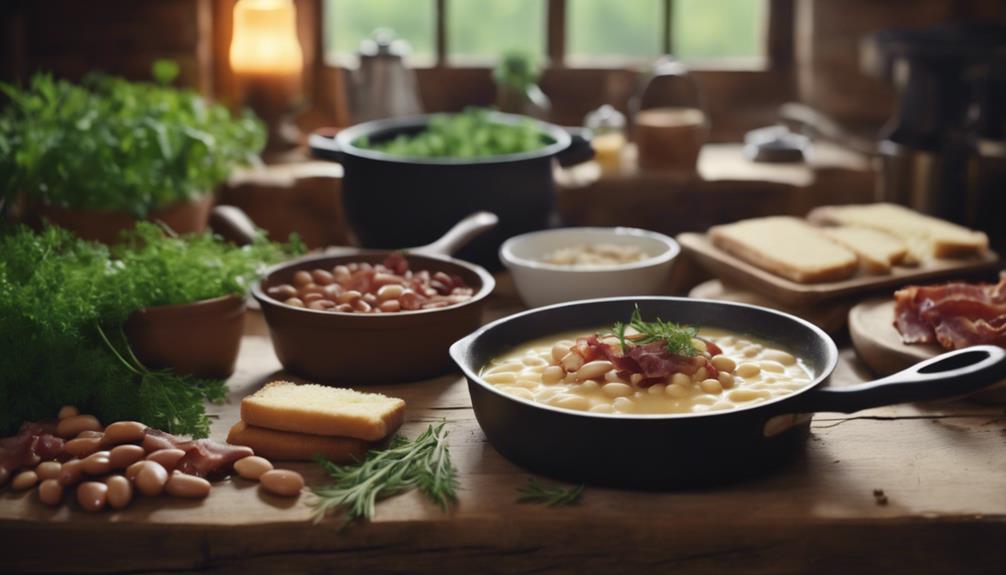
Indulge in the rich, buttery flavors of Southern comfort with the best butter bean recipe that promises hearty satisfaction in every bite. Enhance the creamy texture with bacon, onions, and garlic for a mouthwatering dish. Incorporate ingredients like ham hock for a smoky twist. Don't forget to season with salt, cracked pepper, and brown sugar for a perfect balance. Pair with cornbread or cheddar cheese quick bread to elevate the experience. Experiment with flavors to create the ultimate Southern comfort cuisine. Get ready to elevate your culinary skills and taste buds to the next level with this delicious butter bean recipe!
Key Takeaways
- Butter beans offer a creamy, buttery flavor ideal for Southern comfort cuisine.
- Enhance dishes with ingredients like bacon, onions, and garlic for rich flavors.
- Experiment with flavor combinations like smoky bacon and sweet brown sugar.
- Pair butter beans with cornbread, rice, or cheddar cheese quick bread for a satisfying meal.
- Store leftovers in the fridge for up to five days or freeze for later use.
Butter Bean Vs. Lima Bean
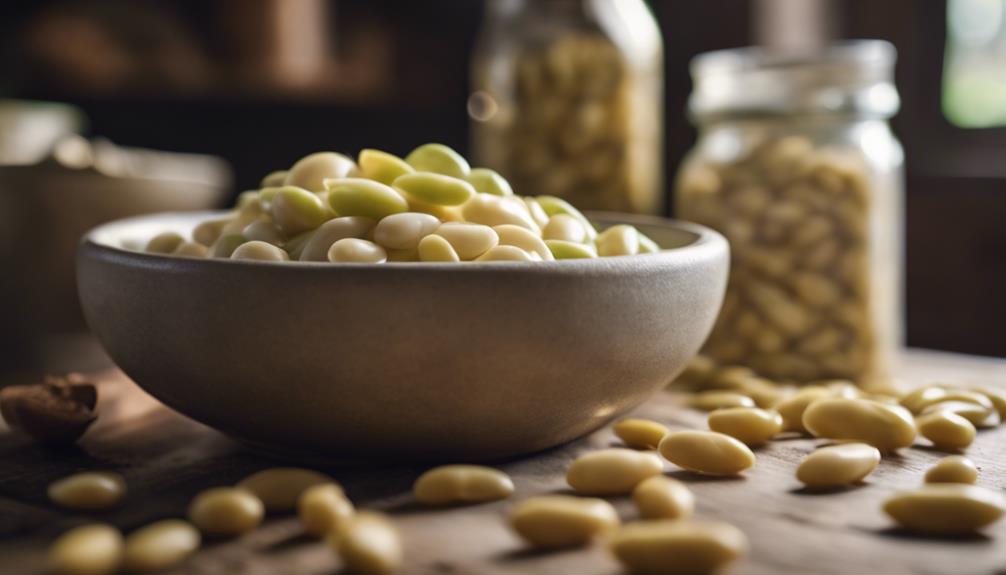
When comparing butter beans to lima beans, you'll notice that butter beans are the larger variety, while lima beans are smaller. Both types are creamy beans with a mild, buttery flavor that make them popular in various dishes.
Originating from Lima, Peru over 9000 years ago, these legumes have become a staple in cuisines worldwide. Large lima beans are commonly found at local grocery stores, perfect for incorporating into your favorite recipes.
In terms of size, butter beans offer a heartier bite compared to the smaller lima beans. The creamy texture of both beans is ideal for dishes that require a smooth consistency, such as soups, stews, and casseroles.
Whether you choose butter beans or lima beans for your next meal, you can expect a deliciously rich and buttery undertone that complements a wide range of ingredients. So, next time you're at the store, consider picking up some large lima beans to elevate your culinary creations.
Flavor Profile and Taste
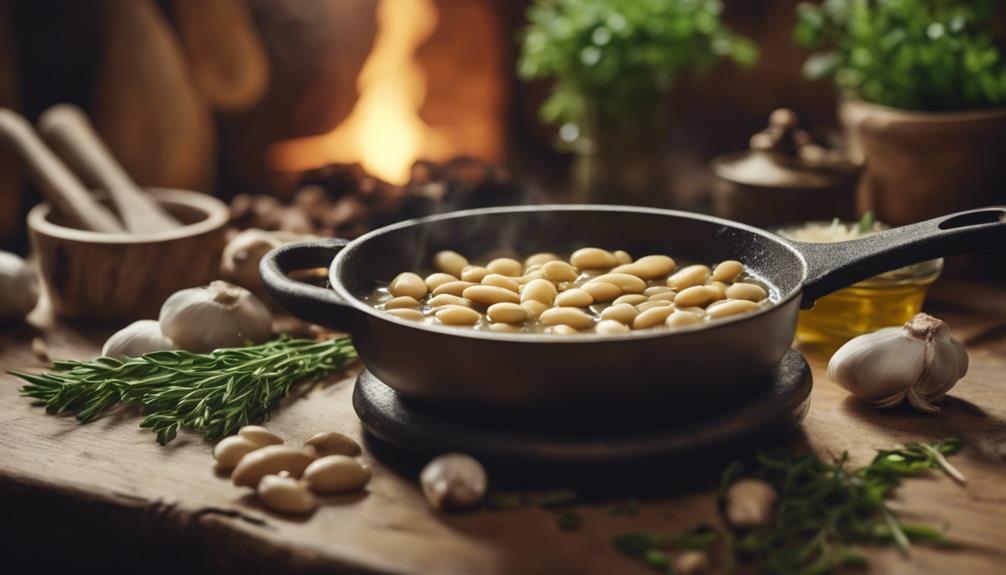
You'll find that butter beans offer a mild, buttery flavor that adapts well to a variety of dishes. Their creamy texture and delicate taste make them a versatile addition to Southern comfort cuisine.
When exploring the flavor profile of butter beans, consider their culinary appeal in classic dishes and how they complement savory ingredients like bacon and onions.
Taste and Texture
Enhancing the flavor profile of butter beans is essential for creating delicious and satisfying dishes. When you make butter beans, whether using large dried beans or canned ones, you'll notice their creamy texture and mild, buttery taste. These characteristics make butter beans versatile for different recipes.
The rich protein and fiber content in butter beans not only provide long-lasting satisfaction but also offer essential nutrients.
Incorporating ingredients like bacon, ham hock, onions, and garlic can elevate the flavor of butter beans, adding depth and complexity to your dishes. These additions complement the beans' mild taste, creating a harmonious blend of flavors.
Whether you're preparing a hearty soup, a comforting stew, a flavorful casserole, a creamy dip, or a revitalizing salad, butter beans can be the star ingredient that brings everything together.
The smooth texture of butter beans contributes to the overall enjoyment of the dish, making each bite a delightful experience. Their versatility and ability to absorb flavors make them a staple in Southern comfort food recipes.
Flavor Combinations
Creating delicious dishes with butter beans involves combining their mild, buttery flavor with savory ingredients like bacon, ham, and onions for a rich and satisfying taste experience.
When preparing butter beans, consider these flavor combinations to elevate your dish:
- Smoky Flavors: Incorporating cooked bacon or ham hock adds a delightful smokiness that enhances the overall taste profile of the butter beans.
- Sweet Elements: Adding a touch of brown sugar complements the natural buttery taste of the beans, creating a harmonious balance of flavors.
- Seasoning: Enhance the taste of butter beans by seasoning them with salt and cracked pepper, which adds depth and a hint of spice to the dish.
- Versatility: The creamy texture of butter beans allows them to pair well with various ingredients, making them versatile for both hearty and light dishes.
Experimenting with these flavor combinations will help you create mouthwatering butter bean dishes that are sure to impress your taste buds.
Culinary Appeal
Butter beans' culinary appeal lies in their mild, buttery flavor that effortlessly complements a variety of seasonings and ingredients. These beans, also known as baby lima beans, offer a creamy texture and are a staple in Southern comfort dishes. Originating over 9000 years ago in Lima, Peru, butter beans have a rich history in cuisines worldwide. Young lima beans are tender and mild, ideal for quick cooking methods that preserve their delicate flavor. The versatile nature of butter beans allows them to be used in soups, stews, casseroles, dips, and salads, adding depth and heartiness to meals.
| Flavor | Texture | Versatility |
|---|---|---|
| Mild, buttery | Creamy | Soups, stews, casseroles |
| Complements seasonings | Tender | Dips, salads |
| Rich history | Versatile | Southern comfort dishes |
Home-Style Recipe Ingredients
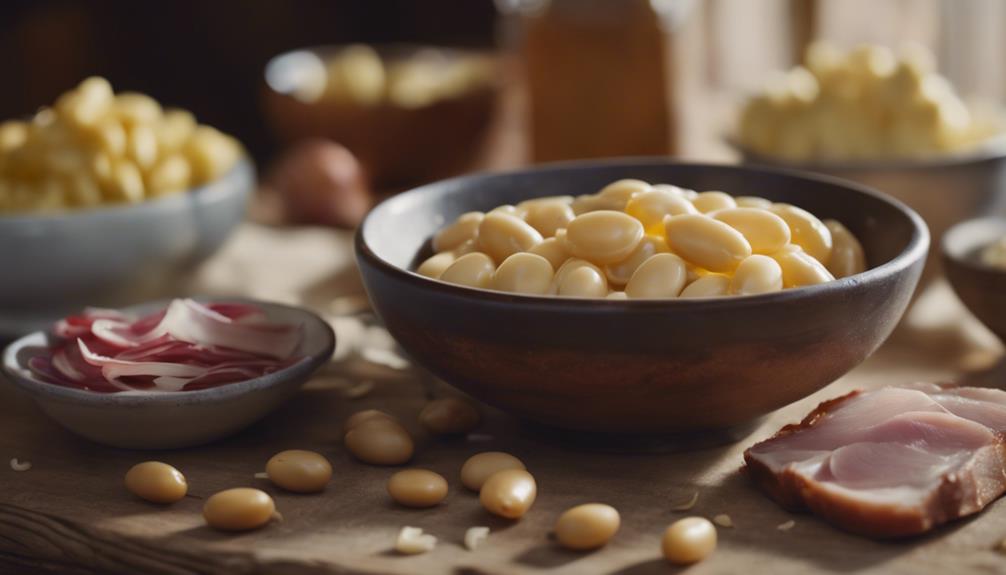
You're about to discover the key ingredients that make up a classic home-style butter bean recipe.
Bacon, onion, brown sugar, butter, salt, and cracked pepper all play crucial roles in creating a flavorful and hearty dish.
These essential ingredients work together to enhance the taste profile of the butter beans, ensuring a delicious and satisfying meal.
Recipe Ingredients Breakdown
To make the home-style butter beans recipe, gather bacon, onion, brown sugar, frozen butterbeans, butter, salt, and cracked pepper. When preparing this hearty dish, each ingredient plays an essential role in enhancing the flavors and textures of the butter beans.
Here's a breakdown of the key components:
- Bacon: Adds a savory smokiness to the dish, infusing it with rich flavors.
- Brown Sugar: Provides a touch of sweetness that balances out the savory notes in the butter beans.
- Frozen Butterbeans: Convenient and quick to cook, these big lima beans are perfect for this comforting recipe.
- Butter, Salt, and Cracked Pepper: Together, these ingredients work harmoniously to elevate the overall taste of the dish, creating a deliciously rich and well-rounded flavor profile.
Key Flavor Enhancements
Enhancing the flavors of the home-style butter beans recipe is essential for creating a delicious and satisfying dish that balances savory and sweet notes. The key to achieving this balance lies in the combination of cooked beans, salt, and pepper.
When seasoning the dish, a pinch of salt and a generous crack of pepper are vital to enhance the natural flavors of the beans and create a well-rounded taste profile.
Cooked beans serve as the hearty base of the dish, providing a robust texture and earthy flavor that pairs perfectly with the other ingredients. Seasoning with salt not only brings out the inherent tastes of the beans but also helps to marry the flavors of the dish together.
Additionally, cracked pepper adds a subtle heat and depth to the butter beans, elevating the overall taste experience. By incorporating these key flavor enhancements into your home-style butter beans recipe, you can enjoy a satisfying and flavorful meal that will leave you craving more.
Cooking Method Details

For achieving peak tenderness and flavor infusion, simmering butter beans in a seasoned broth is a fundamental cooking method detail. This process allows the beans to absorb the flavors of the broth while softening to the perfect texture.
To enhance the cooking method further, consider the following tips:
- Stir well: Regularly stirring the butter beans while simmering helps distribute the flavors evenly and prevents them from sticking to the bottom of the pot.
- Bring to a boil: Start the cooking process by bringing the seasoned broth and butter beans to a boil, then reduce the heat to a simmer to gently cook the beans.
- Add complementary ingredients: Incorporating vegetables, meats like ham hocks, or herbs and spices can elevate the flavors of the butter beans during the cooking process.
- Utilize different cooking techniques: Experiment with stovetop cooking or using a slow cooker to find the method that best suits your preferences and time constraints.
Storage and Reheating Tips
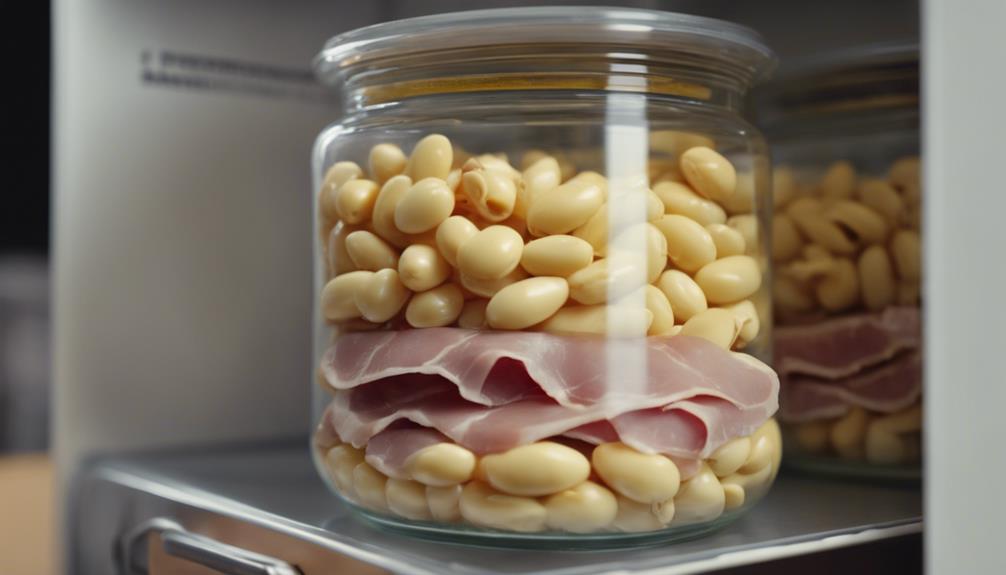
Properly storing and reheating your cooked butter beans is essential for maintaining their quality and flavor. After cooking a delicious batch of butter beans, make sure to refrigerate any leftovers promptly in an airtight container. This will help keep them fresh for up to five days. For longer storage, you can freeze the butter beans for up to three months. When you're ready to enjoy them again, simply thaw the frozen beans in the refrigerator before reheating.
To reheat your butter beans, you have the option of using the stovetop or microwave. Reheating on the stovetop is a great way to ensure even heating and prevent the beans from becoming mushy. Heat them until they are hot and ready to serve. Once reheated, you can enjoy your butter beans as a hearty side dish or incorporate them into various recipes for added flavor and texture.
| Storage Tips | Reheating Tips | Freezing Tips |
|---|---|---|
| Refrigerate in airtight | Reheat on stovetop or | Freeze leftovers for up |
| container for up to five | microwave until hot | to three months |
| days | ||
| Thaw frozen beans in | ||
| the refrigerator before | ||
| reheating |
Side Dish Pairings
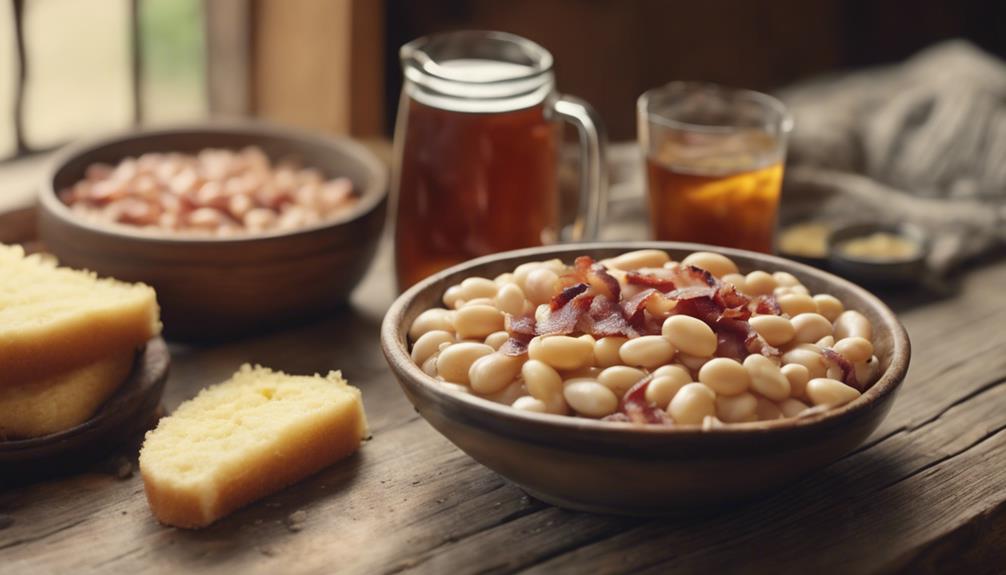
To create a satisfying and well-rounded meal with butter beans, consider pairing them with traditional Southern sides like cornbread, white rice, and cheddar cheese quick bread. These side dishes perfectly complement the creamy texture and mild, buttery flavor of butter beans, enhancing the overall dining experience.
In addition to these classics, you can also enjoy butter beans with bread and butter or Texas Toast to elevate the Southern comfort food experience.
- Butter beans are a classic side dish that pairs well with a variety of Southern staples.
- Traditional accompaniments like cornbread and white rice enhance the rich flavors of butter beans.
- Cheddar cheese quick bread offers a savory twist to the meal, adding depth to the dish.
- Experimenting with different side dishes allows for a personalized touch to your butter bean meal, catering to diverse tastes and preferences.
Southern Comfort Classics
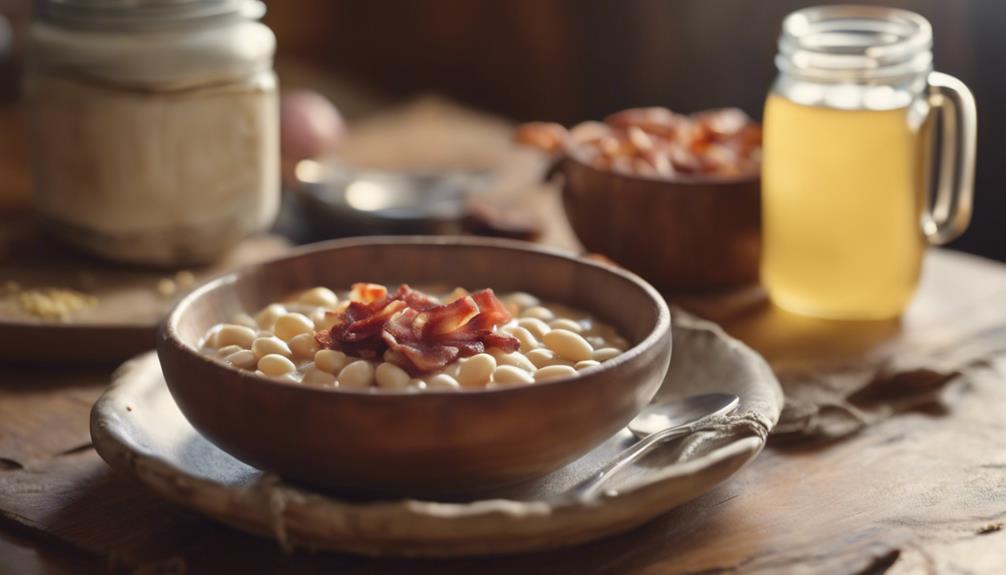
You're about to discover timeless Southern recipes that bring hearty comfort to your table.
These classic dishes embody the warmth and tradition of Southern cooking, offering a taste of nostalgia with every bite.
Get ready to savor the rich flavors and comforting goodness of Southern comfort classics.
Timeless Southern Recipes
When exploring Southern comfort classics, you'll find that butter bean recipes are a beloved staple dish known for their hearty and satisfying nature. These timeless Southern recipes make the most of ingredients like butter beans, which offer a creamy texture and mild, buttery flavor that perfectly complements traditional Southern cooking.
To create an authentic Southern butter bean dish, consider the following:
- Use High-Quality Ingredients: Opt for fresh or dried butter beans, and don't skimp on flavorful additions like bacon or ham hocks.
- Slow Cooking Techniques: Embrace slow cooking methods to allow the flavors to meld together and create a rich, comforting dish.
- Season Thoughtfully: Onions, garlic, and a touch of seasoning can elevate the humble butter bean to new heights of deliciousness.
- Serve with Cornbread: A classic accompaniment to Southern dishes, cornbread pairs perfectly with butter beans for a complete and satisfying meal.
These Southern comfort dishes are sure to become a favorite at family gatherings, offering a taste of tradition and warmth in every bite.
Hearty Comfort Dishes
For those seeking ultimate comfort in their meals, Southern classics offer a range of hearty dishes that bring warmth and satisfaction with every bite. When it comes to preparing these comforting meals, a Dutch oven can be your best friend. Set it over medium heat, and you're ready to create delicious Southern comfort dishes that will surely become family favorites.
The versatility of butter beans shines in traditional Southern recipes like stews, casseroles, and soups, adding a creamy texture and mild, buttery flavor to every dish. With a rich history deeply rooted in Southern cuisine, butter beans have stood the test of time, proving to be a beloved ingredient for generations.
Incorporating butter beans into your cooking repertoire not only pays homage to Southern culinary traditions but also brings a taste of comfort to your table. So, why not whip up a hearty butter bean stew or casserole in your Dutch oven today? Your taste buds will thank you for the cozy Southern goodness that awaits.
Meat Additions and Enhancements
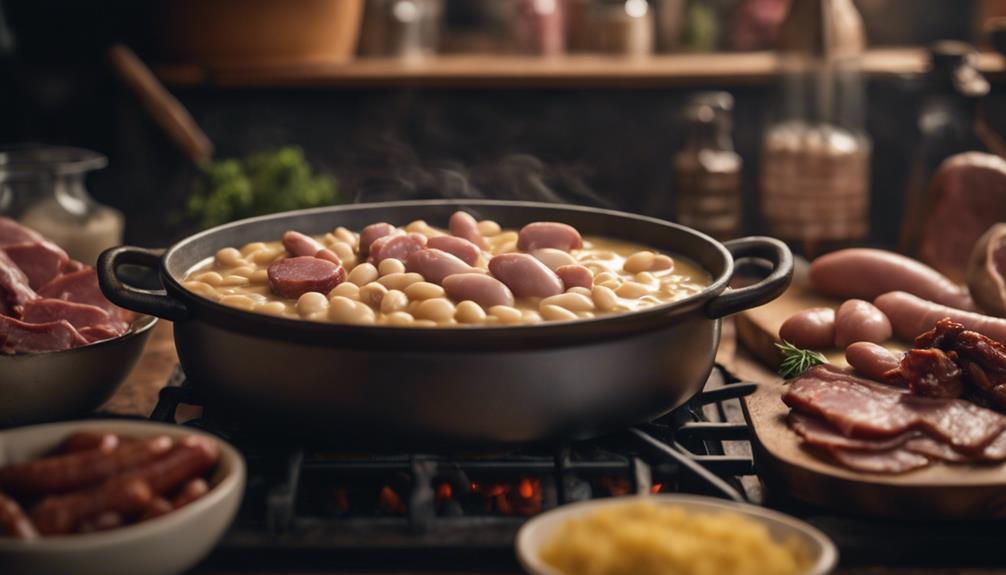
Enhance the flavor and richness of your butter bean recipe by incorporating bacon or ham into the dish. These meat additions not only add depth but also infuse the beans with a savory and smoky essence that elevates the overall taste of the dish.
To make the most of these meat additions, consider the following:
- Bacon: Fry the bacon until crispy, then crumble it into the beans for a burst of salty goodness.
- Ham: Boil the ham hocks alongside the beans to infuse the broth with a rich, meaty flavor.
- Leftover Ham: Utilize any leftover ham by adding it towards the end of cooking to retain its tenderness and taste.
- Butter: If you want to enhance the richness further, reduce the amount of butter needed to add a velvety finish to the beans.
Butter and Oil Options
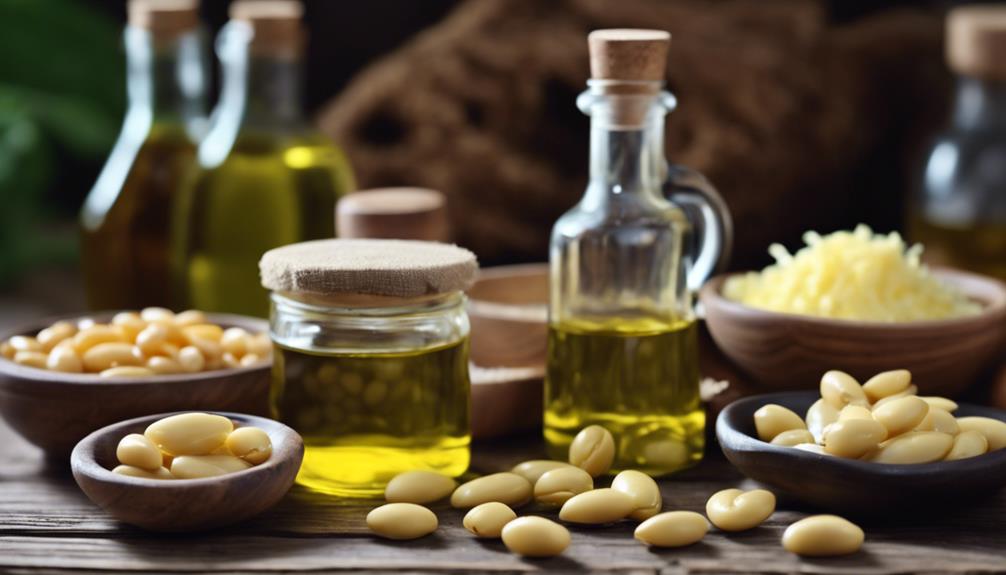
Consider incorporating butter or oil into your butter bean recipe to enhance its flavor and creaminess.
While adding butter isn't a strict requirement, it can greatly improve the overall taste and texture of your dish. If you prefer a dairy-free option or just want to experiment, using oil as a substitute can also achieve that desired creaminess in your beans.
To make this recipe even more indulgent, you may need to add a tablespoon or two of fat per pound of beans during the cooking process. This addition can infuse a rich flavor into the beans, especially when incorporated midway through cooking.
Don't be afraid to try different types of fats to see which one complements your butter beans the best. By choosing the right butter or oil for your recipe, you can elevate the flavors and create a truly satisfying dish.
Leftover Handling and Reheating
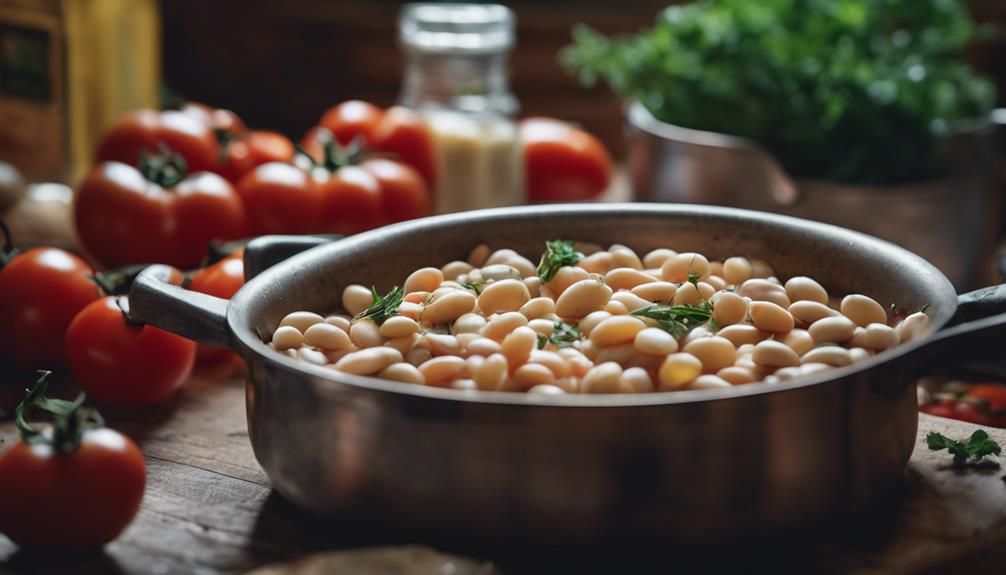
Store your cooked butter beans in an airtight container in the refrigerator for 3-4 days. When dealing with leftovers, proper handling and reheating techniques can help maintain the delicious taste and texture of your butter beans.
Here are some essential tips to make the most of your leftovers:
- Freezing Options: You can freeze cooked butter beans for up to 3 months for future use.
- Thawing Process: Thaw frozen butter beans in the refrigerator before reheating to preserve texture.
- Reheating Methods: Reheat butter beans in the microwave or on the stovetop until thoroughly heated.
- Assessing Consistency: Avoid adding water immediately when reheating butter beans; assess consistency as they heat up.
Frequently Asked Questions
Should I Soak Butter Beans Before Cooking?
You don't have to soak butter beans before cooking, but a quick 30-minute soak can help. It's optional, depending on your preference. Soaking may reduce cooking time and improve texture in some recipes, ensuring even tenderness.
Are Butter Beans Good for Your Heart?
Butter beans are like tiny heart superheroes in a pod. They're packed with fiber, potassium, folate, and magnesium—all working together to support your heart health and keep it ticking strong.
Is There a Difference Between Butter Beans and Lima Beans?
Yes, there isn't a difference between butter beans and lima beans. They're the same type of bean, just with varying names based on size. Enjoy their creamy texture and buttery taste in a variety of dishes!
What Is the American Version of Butter Beans?
In the US, butter beans are the American version of lima beans. These creamy legumes, often used in Southern cooking, offer a mild, buttery taste. So, when looking for butter beans, know you're getting a true Southern favorite!
Conclusion
To sum up, whether you choose butter beans or lima beans, the hearty and comforting flavors in this recipe will satisfy your cravings.
From the rich and creamy texture to the savory seasonings, each bite will transport you to a Southern kitchen.
So go ahead, whip up a batch of this classic dish and enjoy the warmth and nostalgia it brings to your table. It's a simple yet delicious way to experience true Southern comfort.
Sunny’s articles radiate enthusiasm, much like her sunny disposition. As our resident “Butter Geek”, she delves deep into the latest butter trends, ensuring our readers are always in the know. Beyond her writing, Sunny’s passion lies in exploring vegan butter alternatives and hosting butter-tasting soirées.
Recipes & Culinary Uses
Playtime Fun: Best Butter Slime Recipe for Kids!
Are you ready to create the best butter slime for your kids?

Ready to create the best butter slime for your kids? Mix white glue and shaving cream, then add Crayola Model Magic clay for texture. Knead the ingredients until smooth and adjust with more clay if needed. This slime is perfect for sensory play, boosting fine motor skills, and offering stress relief. Get creative by hiding treasures in the slime or making a slime volcano. Enhance tactile exploration and cognitive development with this fun activity. Discover the endless playtime possibilities and benefits of butter slime that will keep your kids entertained and engaged for hours!
Key Takeaways
- Use white glue, shaving cream, and Model Magic clay for fluffy and buttery texture.
- Follow 1/2 cup glue, 1/2 cup shaving cream, then slowly add clay.
- Knead until smooth consistency, adjust with more clay if needed.
- Store in an airtight container to maintain texture and prevent drying out.
- Enjoy sensory play, creativity, and stress relief with safe and entertaining butter slime.
Butter Slime Ingredients
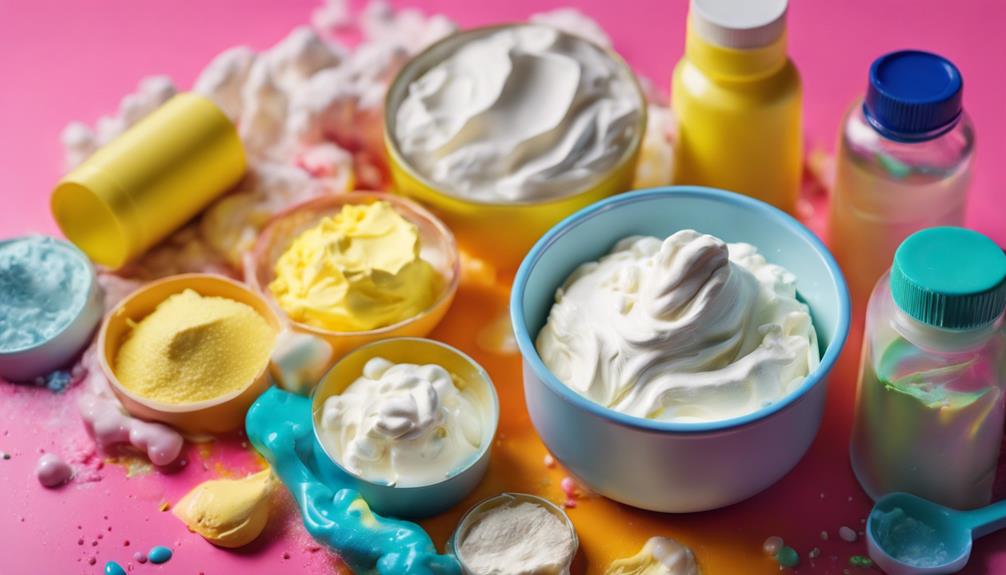
You'll need specific ingredients to create the perfect batch of butter slime for your kids. Start by gathering a cup of white school glue, a cup of Elmer's glue, baking soda, shaving cream, Crayola Model Magic clay, food coloring, lotion, and an airtight container for storage.
The white school glue, also known as PVA glue, forms the base of the slime. Shaving cream adds fluffiness and volume, while the Model Magic clay is essential for achieving that signature buttery texture. Food coloring allows for customization, and lotion can be added for extra stretchiness and softness.
Properly storing your butter slime in an airtight container will help maintain its texture and prevent it from drying out. These specific ingredients, when combined in the right proportions, will result in a delightful batch of butter slime that your kids will love playing with for hours.
How to Make Butter Slime
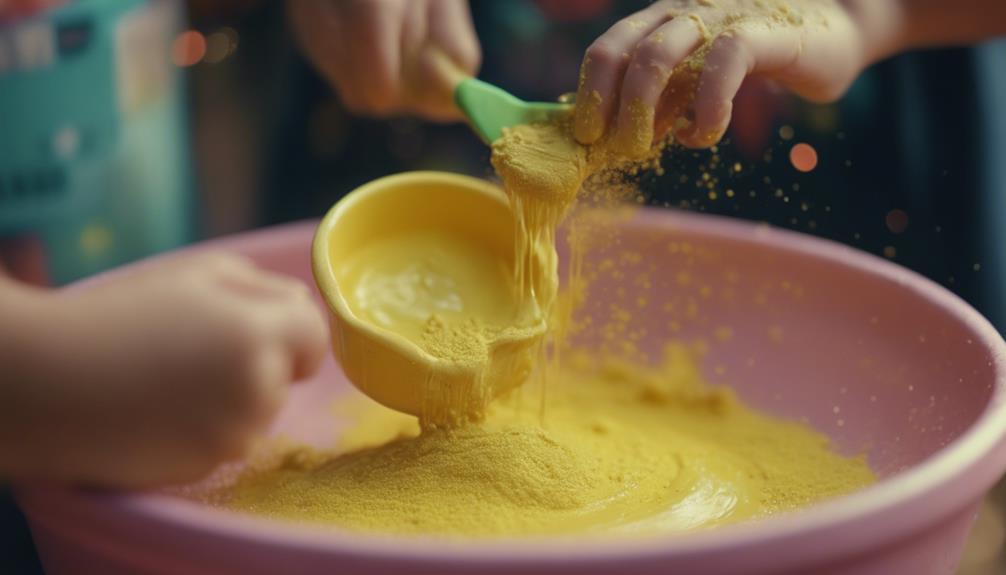
To create butter slime, begin by mixing together the glue and shaving cream in a bowl. Then, add the desired amount of clay to enhance the texture and stretchiness of the slime. Here's a simple guide to help you make your own butter slime:
| Ingredients | Amount |
|---|---|
| White Glue | 1/2 Cup |
| Shaving Cream | 1/2 Cup |
| Model Magic Clay | As needed |
First, pour the white glue and shaving cream into a mixing bowl. Mix them thoroughly until well combined. Next, slowly incorporate the Model Magic clay into the mixture. Knead the slime with your hands until you achieve a smooth and spreadable consistency. If the slime is too sticky, you can add a bit more clay. Once you've reached the desired texture, your butter slime is ready for playtime fun with the kids! Enjoy the process of making and playing with this delightful sensory material.
Benefits of Butter Slime
Butter slime offers children a sensory-rich and therapeutic play experience, promoting creativity and fine motor skill development. Engaging in sensory play with butter slime can help children explore different textures, colors, and scents, stimulating their senses and fostering creativity.
The squishy and stretchy nature of butter slime provides stress relief for children, offering a therapeutic outlet for them to relax and unwind. Manipulating butter slime also helps enhance fine motor skills as kids pinch, squeeze, and mold the slime, improving their hand-eye coordination and dexterity.
Moreover, butter slime is a safe activity suitable for kids of all ages, providing hours of entertainment and learning. By storing butter slime properly in an airtight container, you can guarantee its longevity for continued play over several days.
Playtime Ideas With Butter Slime

For an engaging and creative playtime experience with butter slime, consider trying out these fun and educational activities with your child. Using butter slime in play can be a great way to have fun and learn simultaneously. Check out the table below for some exciting ideas to explore with your child:
| Playtime Ideas | Benefits | Keywords |
|---|---|---|
| Hide treasures in slime | Encourages sensory play and imaginative exploration | play,fun,sensory play,imagination |
| Spell out names with slime | Enhances fine motor skills and promotes letter recognition | using,butter slime recipe,fine motor skills |
| Create a slime volcano | Hands-on science experiment teaching about chemical reactions | creative,science experiment |
| Slime garden activity | Fosters creativity and imagination with the addition of plants and figurines | fun,kids activities,imagination |
| Self-portrait with slime | Develops perceptual awareness in children through a sensory play activity | sensory play,creative |
These activities not only provide entertainment but also offer a chance for your child to learn and grow through play.
Sensory Activities With Butter Slime

Engage your child in sensory activities with butter slime to enhance their tactile exploration and foster creativity. Kids love the smooth and spreadable texture of butter slime, making it perfect for sensory play. This type of slime offers a unique sensory experience, encouraging children to touch and manipulate it, stimulating their fine motor skills development.
By incorporating butter slime into playtime, you can create a calming and engaging sensory play session that promotes hands-on learning and cognitive development. These sensory activities not only provide a fun and interactive way for kids to play but also help in boosting their cognitive skills through sensory exploration.
Let your child immerse themselves in the world of sensory play with butter slime, where they can explore, create, and learn in a tactile and exciting manner. Make playtime fun and educational with sensory activities that spark imagination and creativity.
Frequently Asked Questions
How to Make Butter Slime for Kids?
To make butter slime for kids, you'll need white school glue, shaving cream, cornstarch, lotion, and Model Magic clay for stretchiness. Customize with colors, glitter, or sequins. Encourage fine motor skills and creativity through fun sensory play.
How to Make Butter Slime With 3 Ingredients?
To make butter slime with 3 ingredients, grab white glue, shaving cream, and cornstarch. Mix them together for a smooth, cloud-like texture. Remember, simplicity is key – less is more when it comes to creating this fun sensory play material!
What Is the Best Activator for Butter Slime?
To make the best butter slime, experiment with Borax, saline solution, or liquid starch as activators. Find what works for you, whether it's Borax for effectiveness, saline for gentleness, or liquid starch for good results.
How to Make Butter Slime With 2 Ingredients?
Mix hair conditioner and cornstarch in a bowl. Knead the soft dough until smooth. Add sparkles for extra flair. Immerse yourself in this easy, no-cook activity with your kids for a sensory delight that's bound to be a hit!
Conclusion
Now that you've got your butter slime ready, get ready for hours of squishy, stretchy fun!
Let your imagination run wild as you mold and shape this creamy concoction.
Remember, the possibilities are as endless as the buttery swirls in your slime.
So go ahead, immerse yourself and let your creativity flow like a river of melted butter!
Sunny’s articles radiate enthusiasm, much like her sunny disposition. As our resident “Butter Geek”, she delves deep into the latest butter trends, ensuring our readers are always in the know. Beyond her writing, Sunny’s passion lies in exploring vegan butter alternatives and hosting butter-tasting soirées.
Recipes & Culinary Uses
Cookie Mastery: Best Recipe for Peanut Butter Cookies!
Fulfill your cookie cravings with the ultimate peanut butter cookies recipe that promises a decadent symphony of flavors – you won't want to miss out!
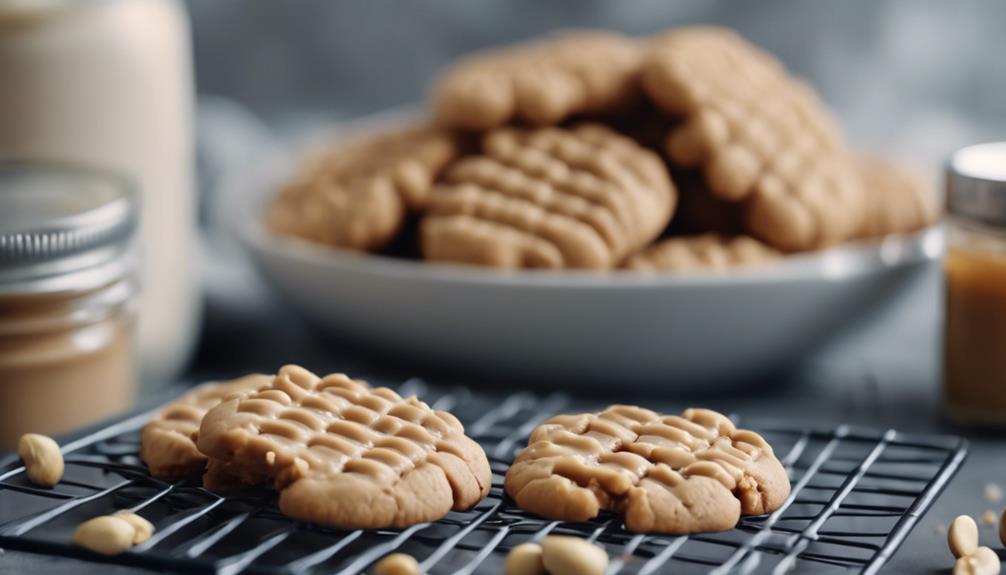
Get ready for the ultimate peanut butter cookies! Combine peanut butter, brown sugar, egg, and baking soda. Mix in chocolate chips and bake at 350°F. Enjoy a soft, chewy treat with a golden brown color. The robust peanut butter taste, sweet brown sugar, and rich chocolate chips create a decadent symphony of flavors. Each cookie provides 245 calories, with a balance of carbohydrates, protein, and fat. Pair with milk or coffee for an enhanced experience. Stay tuned for more serving suggestions and detailed reviews to keep your cookie cravings satisfied.
Key Takeaways
- Soft and chewy texture with golden brown color for irresistible appeal.
- Robust peanut butter taste complemented by sweet brown sugar.
- Decadent chocolate chips offer bursts of rich flavor.
- Thick cookies with crisp edges and soft centers for a delightful mouthfeel.
- Easy to make, perfect for parties, and pairs well with milk or coffee.
Recipe Ingredients and Preparation
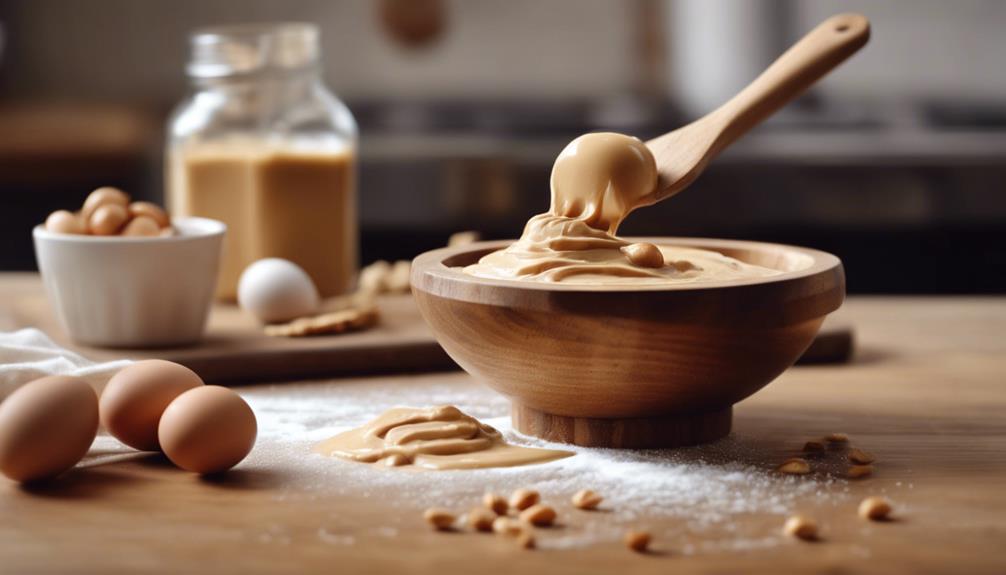
To make these delicious peanut butter cookies, gather creamy peanut butter, brown sugar, a large egg, baking soda, and chocolate chips.
Start by mixing the peanut butter, brown sugar, egg, and baking soda until well combined.
Then, gently fold in the chocolate chips to ensure uniform distribution of the sweet morsels throughout the dough.
Roll the dough into balls and place them on a baking sheet lined with parchment paper.
Bake the cookies at 350°F for 10-12 minutes until they're soft, thick, and golden brown.
As they bake, the aroma of peanut butter and chocolate will fill your kitchen, making it hard to resist peeking into the oven.
Once done, allow the cookies to cool slightly before indulging in their rich peanut butter taste, sweetness from the brown sugar, and bursts of flavor from the chocolate chips.
These peanut butter cookies are the perfect treat for any occasion, offering a satisfying blend of flavors in every bite.
Texture and Appearance Details
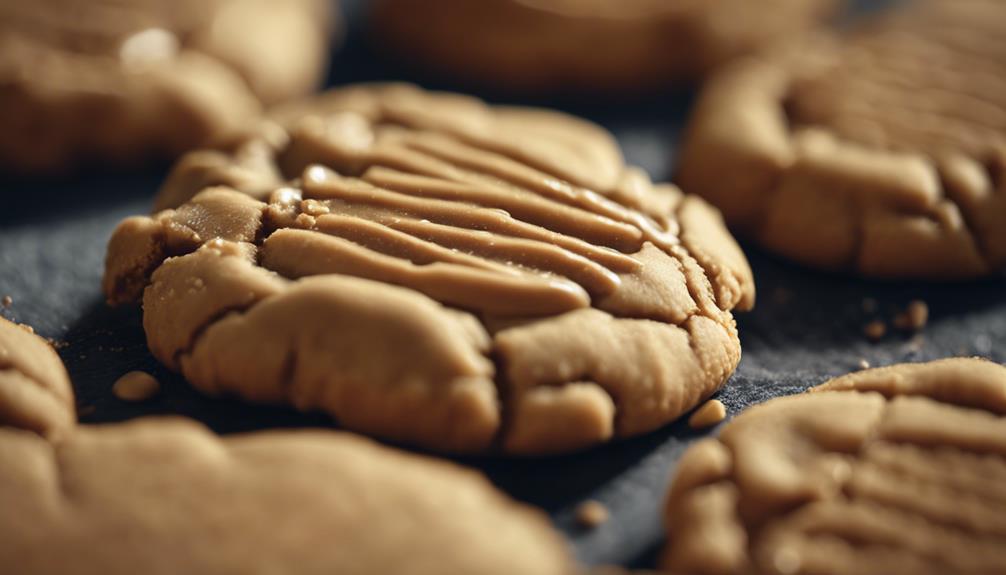
The soft and chewy texture of these peanut butter cookies, coupled with their golden brown color and delightful chocolate chip accents, make them a visually appealing and irresistible treat. As you bite into these cookies, you'll experience a satisfying thickness that offers a substantial chewiness, creating a delightful mouthfeel. The golden brown hue of the cookies, with crisp edges and a soft center, invites you to indulge in their homemade goodness. Chocolate chips scattered throughout each cookie not only enhance the flavor but also provide a pop of visual interest, adding to the overall allure of these treats. Additionally, the aroma that fills your kitchen as these cookies bake is simply irresistible, with the rich scent of peanut butter enveloping your senses. Below is a table summarizing the key texture and appearance details of these peanut butter cookies:
| Texture | Appearance | Additions |
|---|---|---|
| Soft | Golden brown | Chocolate chips |
| Chewy | Crisp edges | |
| Substantial | Soft center |
Flavor Profile Description
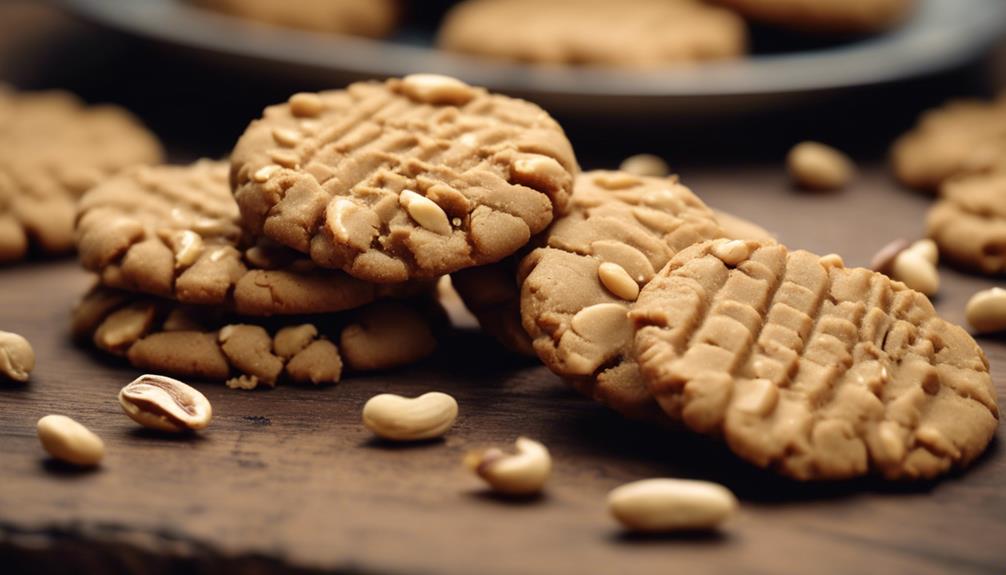
Peanut butter takes center stage in every decadent bite of these cookies, enchanting your taste buds with its rich and nutty essence. The flavor profile of these peanut butter cookies is a delightful symphony of tastes that will leave you craving more.
Here's why:
- Peanut Butter Taste: The unmistakable flavor of creamy peanut butter is the star of these cookies, providing a robust and nutty undertone that lingers with each bite.
- Brown Sugar Sweetness: The addition of brown sugar adds a perfect touch of sweetness that complements the peanut butter taste, creating a well-balanced and indulgent flavor profile.
- Chocolate Chips: The chocolate chips scattered throughout the cookie dough offer bursts of rich and decadent flavor, contrasting beautifully with the nuttiness of the peanut butter and adding an extra layer of deliciousness to each cookie.
Together, these elements harmonize to create a flavor profile that's both comforting and irresistible, making these peanut butter cookies a favorite treat for any occasion.
Nutrition Information Breakdown
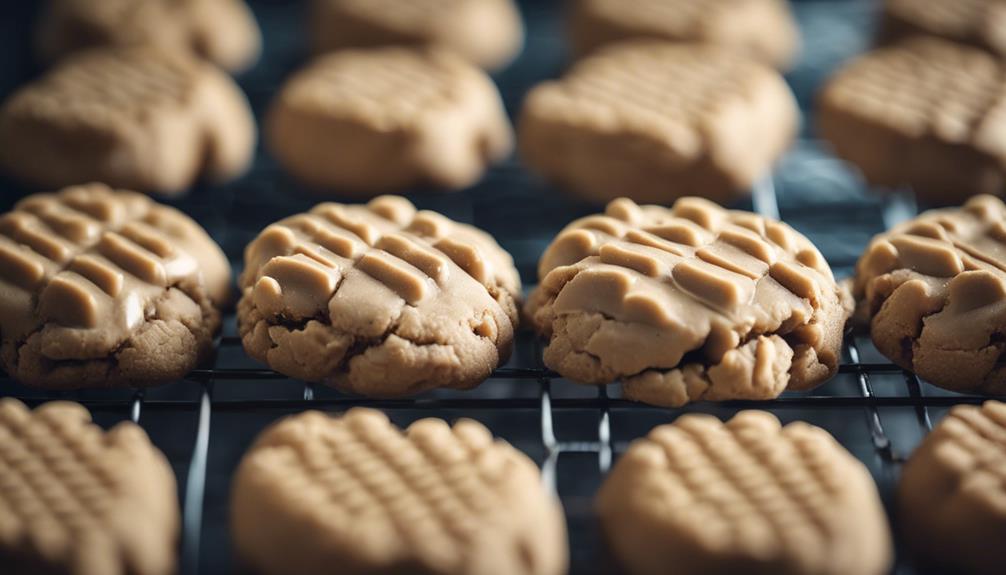
Shifting from the flavor profile description, let's now take a closer look at the nutrition information breakdown of these delectable peanut butter cookies. Each serving of these cookies contains 245 calories, making them a reasonable treat for your sweet cravings.
The 27g of carbohydrates offer a delightful sweetness, while the 4g of protein in a single cookie contributes to a balanced snack option. With 13g of fat per cookie, these treats provide a rich and flavorful experience that has garnered rave reviews.
To bake these scrumptious cookies, make sure you use a cookie sheet lined with parchment paper to prevent sticking. The recipe calls for unsalted butter to control the sodium content, which amounts to 152mg per serving.
It's important to enjoy these cookies in moderation due to their calorie and fat content. However, their protein and carbohydrate balance makes them a satisfying indulgence for any cookie lover.
Serving Suggestions and Reviews
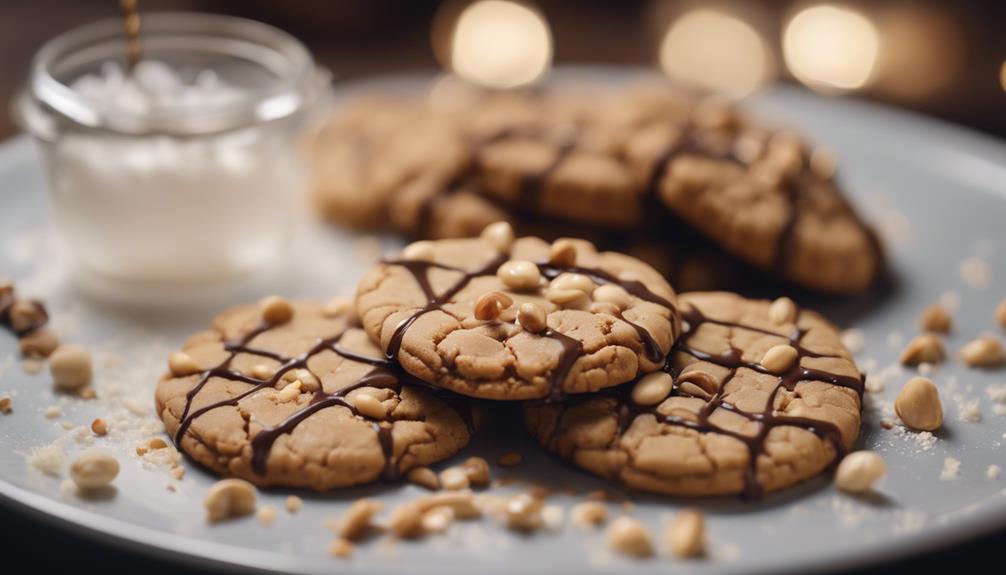
Enhance your cookie-eating experience by pairing these delightful peanut butter cookies with a glass of milk or a cup of coffee. Reviewers have expressed positive feedback on the cookies' taste and texture, with many delighted by the recipe's success. Taking the time to bake these cookies will be well worth it based on the glowing reviews and high ratings they've received.
Here are some things reviewers liked about this recipe:
- The cookies' soft and thick texture that makes them perfect for parties or gatherings.
- The cookies' ability to pair exceptionally well with a glass of milk or a cup of coffee, enhancing the overall flavor experience.
- The ease of storing the cookies for a few days without compromising on freshness, allowing for continued enjoyment over time.
Frequently Asked Questions
Is It Better to Use Butter or Shortening in Peanut Butter Cookies?
For peanut butter cookies, use butter for flavor and richness, or shortening to maintain shape. Butter yields softer texture, while shortening gives a firmer bite. The choice depends on your preference for taste and texture.
Why Are My Peanut Butter Cookies Always Hard?
Overbaking leads to hard cookies. Guarantee precise baking time. Too much flour or insufficient fat causes dry dough and hardness. Cream butter and sugar moderately to prevent crumbliness. Excessive mix-ins make cookies dense. Improper storage dries out cookies, making them hard.
Why Are My Peanut Butter Cookies Crumbling and Falling Apart?
Your peanut butter cookies may be crumbling due to overbaking, excess flour, insufficient fat, too much leavening agent, or inadequate mixing. Adjust baking time, ingredients, and mixing technique to achieve cookies that hold together perfectly.
What Are the Basic Ingredients for Peanut Butter Cookies?
You need creamy peanut butter, brown sugar, egg, and baking soda for peanut butter cookies. They taste nutty and sweet, with a soft, chewy texture. Add chocolate chips for extra flavor. Just mix, bake, and enjoy these delicious treats!
Conclusion
You've mastered the art of baking with this peanut butter cookie recipe!
Did you know that Americans consume over 7 billion cookies a year?
So next time you whip up a batch of these delicious treats, know that you're contributing to that sweet statistic.
Keep baking and enjoy every bite of these irresistible peanut butter cookies!
Sunny’s articles radiate enthusiasm, much like her sunny disposition. As our resident “Butter Geek”, she delves deep into the latest butter trends, ensuring our readers are always in the know. Beyond her writing, Sunny’s passion lies in exploring vegan butter alternatives and hosting butter-tasting soirées.
-

 Recipes & Culinary Uses4 months ago
Recipes & Culinary Uses4 months agoMake Homemade Butter from Milk at Home
-

 Shopping Guides4 months ago
Shopping Guides4 months agoWhere to Buy Raw Butter
-

 Butter Tips and Tricks6 months ago
Butter Tips and Tricks6 months agoChurn Butter the Old Fashioned Way: 3 Traditional Steps
-

 Recipes & Culinary Uses5 months ago
Recipes & Culinary Uses5 months agoHow Many Sticks of Butter Equals a Pound: A Handy Guide
-

 Recipes & Culinary Uses4 months ago
Recipes & Culinary Uses4 months agoMake Creamy Butter From Buttermilk
-
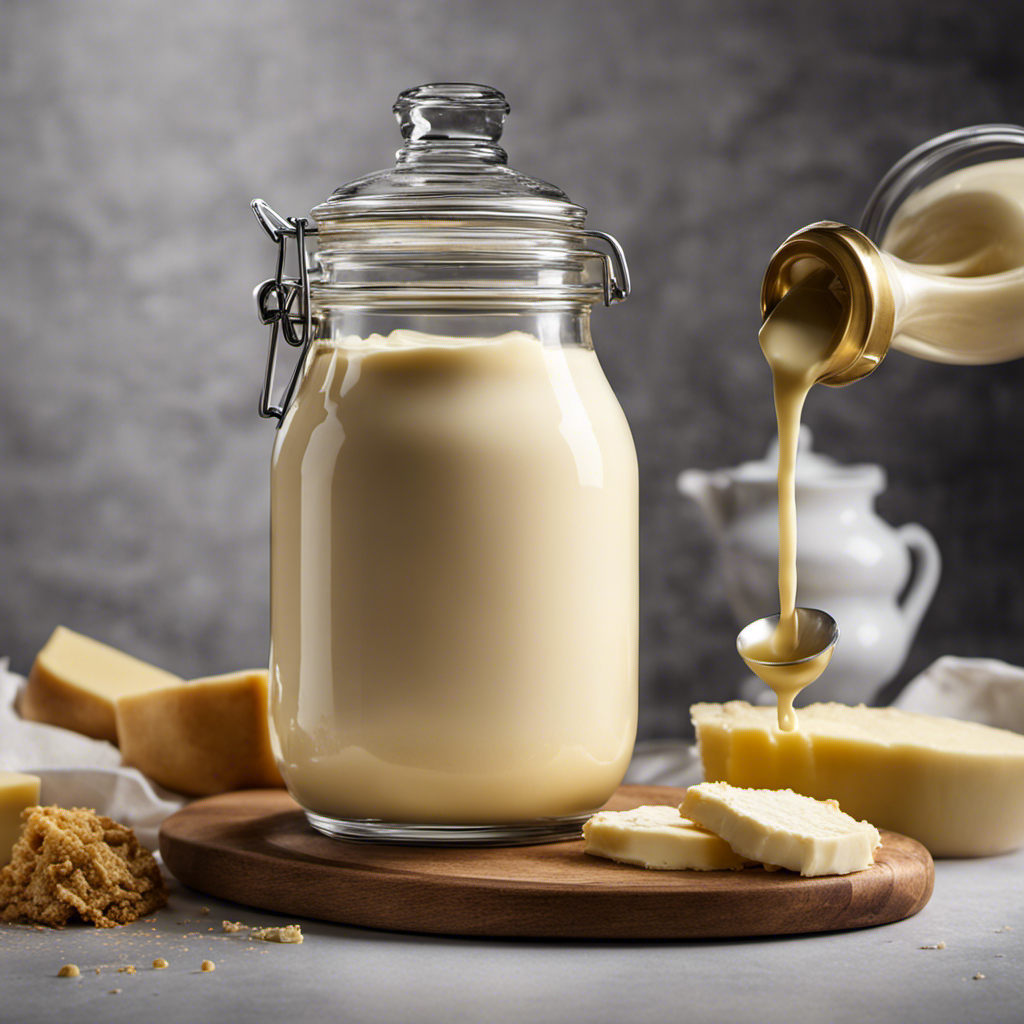
 Butter Tips and Tricks6 months ago
Butter Tips and Tricks6 months agoHow Much Heavy Cream to Make Butter: A Step-by-Step Guide
-
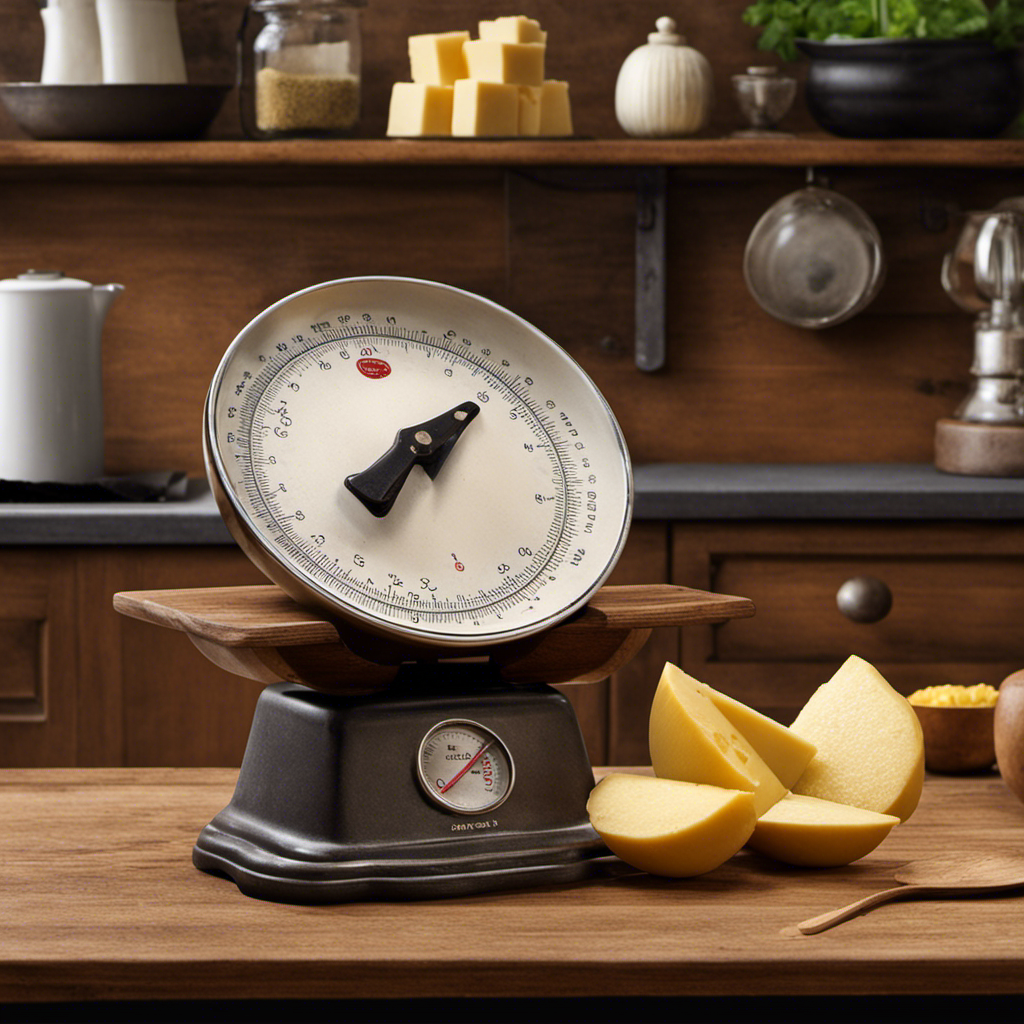
 Butter Tips and Tricks6 months ago
Butter Tips and Tricks6 months agoHow Many Sticks of Butter in 2/3 Cup: A Simple Guide
-

 Recipes & Culinary Uses5 months ago
Recipes & Culinary Uses5 months agoMake Your Own Homemade Spray Butter







